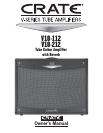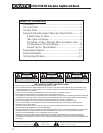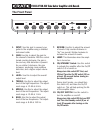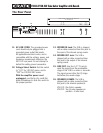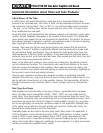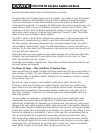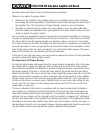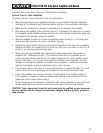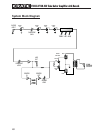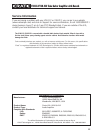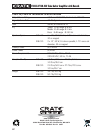
V18-112/V18-212 Tube Guitar Amplifier with Reverb
8
Whenever you replace the power tube(s):
• Always have the amplifier’s bias voltage checked by a qualified service center. Improper
bias voltage will cause degradation in performance and possibly damage the tubes and/or
the amplifier. (See “The Importance of Proper Biasing”, below for more information).
• We highly recommend that you replace the driver tube(s) as well. The driver tube deter-
mines the shape and amplitude of the signal applied to the power tube(s) and has to work
almost as hard as the power tube(s).
You can check your preamplifier tubes for microphonics by turning the amplifier on, turning up
the gain and tapping lightly on each tube with the end of a pencil or a chop stick (my favorite).
You will be able to hear the tapping through your speakers, which is normal. It is not normal
for a tube to ring like a bell after it’s tapped. If it does ring then it’s microphonic and should be
replaced. Remember to use only high quality, low microphonic tubes in the preamplifier section.
Even though power tubes are rarely microphonic, you should check them anyway. The power
tubes can be checked for microphonics just like pre-amp tubes.
In the case of very high gain amps, you may be able to reduce the amount of noise generated
by simply swapping the preamp tubes around.
The Importance Of Proper Biasing:
For the best performance and longest tube life, proper biasing is imperative. Bias is the nega-
tive voltage which is applied to the power tube’s control grid to set the level of idle current.
We cannot over emphasize the difference in warmth of tone and dynamic response that come
with proper biasing. If the bias is set too high (over biased), the sound from the amp will be
distorted at all levels. If the bias is set too low, (under biased) the power tubes will run hot (the
plates inside the tubes may glow red due to excessive heat) and the sound from the amplifier
will lack power and punch. The excessive heat greatly reduces tube life – from a few days to
as little as a few hours in extreme cases. Setting the bias on your amp is like setting the idle
on your car. If it’s too high or hot it’s running away with you and if it’s too low or cold it will
choke when you step on it.
The bias is adjusted at the factory in accordance with the type of power tube(s) installed in
your amplifier. It is important to point out that tubes of the same type and specification typi-
cally exhibit different performance characteristics. Consequently, whenever power tubes are
replaced, the bias voltage must be checked (unless the amplifier is equipped with “self-biasing”
circuitry) and readjusted to accommodate the operating parameters of the replacement tubes.
Depending on the model and amplifier type, there may be hum balance controls, trim pots, or
bias adjustment controls on its rear panel. However, the bias adjustment should be performed
only by qualified service personnel with the proper, calibrated test equipment.
Important Information About Tubes and Tube Products (continued):



